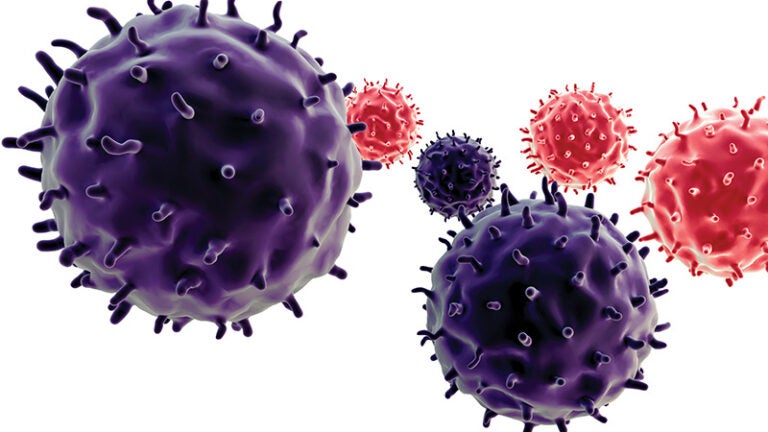
Power to the Patient
In April 2000, Peter Kuhn stepped off a plane in Athens, Greece. It was his first trip to the city, the center of civilization in ancient times.
Hailing a cab outside the airport, he slipped into the back seat and handed the driver the address of his hotel destination, then settled in for the ride. About an hour later, they arrived. The cost: $100.
“Two days later, back to the airport from the same hotel was just shy of a $20 cab ride that took no more than 10 minutes,” said Kuhn, Dean’s Professor of Biological Sciences and professor of medicine, biomedical engineering, and aerospace and mechanical engineering. The first driver had taken advantage of Kuhn’s unfamiliarity with Athens and unnecessarily extended the trip, running up the bill.
Kuhn had actually enjoyed that scenic ride, so he didn’t mind the swindle too much, but he now marks the incident as an important lesson in how times have changed.
“Interestingly enough, that wouldn’t happen again today,” he said, noting the explosion of GPS and cell phone technologies. These advances, the kind used by driving services such as Lyft and Uber, bring a new level of transparency to the process. Both driver and passenger know how long the trip should take. And by using navigation services and apps to gather data from other users on similar paths in the vicinity, they can choose to change the route to avoid traffic or skirt construction.
Kuhn, who also is associate director of the Bridge Institute at the USC Michelson Center for Convergent Bioscience, wants to bring this same kind of transparency, along with the decision-making power it provides, to cancer treatment.
“It doesn’t matter where I am, using my GPS and overlaying local real-time traffic, I can see how long the trip will take or detours that might be an advantage,” he said. The same should essentially be true for patients. That is his vision behind initiatives such as CancerBase and ATOM-HP (Analytical Technologies to Objectively Measure Human Performance).
Both projects were highlighted as part of former vice president Joe Biden’s Cancer Moonshot program. They aim to gather data in real time from doctors, patients and researchers and make the information available immediately in an easily understood format.
ATOM-HP — developed in collaboration with USC Norris Comprehensive Cancer Center; the Keck School of Medicine of USC; the USC Viterbi School of Engineering; and the USC Jimmy Iovine and Andre Young Academy — uses wearable technology and smartphones to monitor patients. Current cancer treatment and monitoring is confined to clinic visits, sometimes weeks apart. ATOM-HP enables continuous, real-time data capture, eliminating gaps in the process.
CancerBase is a social media-based tool. Kuhn’s team along with colleagues from the Keck School of Medicine, USC Iovine and Young Academy and Stanford University designed CancerBase to empower patients to share their experiences anonymously in a format akin to Facebook and other online social platforms.
Much like current navigation apps, which gather data from many users on similar paths, ATOM-HP and CancerBase will process the data received to allow patients to team with physicians and choose, at any time during treatment, the path best suited to their individual needs.
“It will let patients compare their experiences with others like them and make choices that fit their needs,” Kuhn said. A 30-year-old mother facing breast cancer, for example, might opt for a treatment with a slightly higher risk of recurrence than chemotherapy but avoids the cognitive side effects of “chemobrain,” so she can continue to attend to her young children’s needs. A 75-year-old prostate cancer patient may decide the risks of surgery outweigh the 10 percent chance of death from his particular form of the disease over the next 15 years.
Personal preferences and social concerns can be just as important as the need to tackle the cancer, Kuhn said.
Kuhn speaks not just from an academic view. Much of his work is rooted in a very personal experience: His mother was diagnosed with breast cancer when he was 18.
Though her treatment was successful, every unexplained pain she felt has been a source of concern for the past 30 years, he said.
“I grew up with that worry, conscious of this constant fear because pain is indeed often the first indication of metastatic progression. Even though the physicians monitor patients, still too often the first indication the disease has returned and spread is pain.” By then, the cancer has a renewed virulence.
Kuhn finds the status quo — relying on a patient to report pain and then having to determine if further testing is warranted — difficult to accept. “That means that we as scientists have really failed the patients. It’s ridiculous.”
Technologies such as ATOM-HP and CancerBase, he believes, could be the key to turning that around, providing the appropriate tools to both the treating physician and the patient. Using social media and the latest data-harnessing technology to analyze large amounts of the most current data will help patients and doctors track health from the initial diagnosis, through treatment and well after. And researchers can use the information to further advance treatment.
“We need a continuum of care to support the continuum of disease,” he said. “If we want a continuum of care, we need to have a continuum of data to support that, and we need a spectrum of technologies for both the health and the disease of that patient to support that. We have to build that out.
“It all fits in this bigger picture,” he said. “Convergent science at USC enables us to bring this all together and indeed deliver solutions to the wicked problem of cancer.”
Read more stories from USC Dornsife Magazine’s Spring/Summer 2017 issue